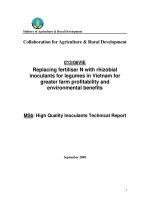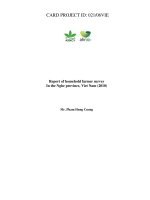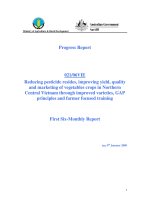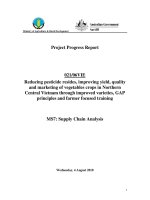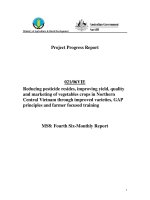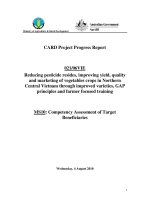Báo cáo khoa học nông nghiệp " Selection and development sweet potato varieties with high root quality for food processing in Northern and Central of Vietnam " MS4 pot
Bạn đang xem bản rút gọn của tài liệu. Xem và tải ngay bản đầy đủ của tài liệu tại đây (189.57 KB, 16 trang )
Bộ Nông nghiệp và Phát triển nông thôn (MARD)
008/07VIE
Selection and development sweet potato varieties with
high root quality for food processing in Northern and
Central of Vietnam
MS4
Evaluation and selection of new sweet potato varieties
in Bac Giang, Thanh Hoa and Quang Tri 2008-2009
July 2008
2
Institute Information
Project Name
008/07VIE_Commercial and High Quality
Cultivars of Root and Tuber Crops for Processing
Purpose in the Northern and Central Vietnam
Vietnamese Institution
Food Crops Research Institute Food Crops Research
Institute
Vietnamese Project Team Leader
A/Prof. Dr. Nguyen Van Tuat
Australian Organisation
Faculty of Agriculture, Food and Natural Resources,
University of Sydney
Australian Personnel
Prof. Dr. Les Copeland
Date commenced
02/2008
Completion date (original)
12/2009
Completion date (revised)
02/2010
Reporting period
First six months
Contact Officer(s)
In Australia: Team Leader
Name:
Prof. Dr. Les Copeland
Telephone:
+61 2 9351 2935
Position:
Professor
Fax:
+ 61 2 9351 2945
Organisation
Faculty of Agriculture, Food and
Natural Resources,
University of Sydney
Email:
In Australia: Administrative contact
Name:
Annette Vervoort
Telephone:
61 2 9351 8795
Position:
Adm. Assistant
Fax:
61 2 9351 4172
Organisation
Faculty of Agriculture, Food and
Natural Resources,
University of Sydney
Email:
In Vietnam
Name:
A/Prof. Dr. Nguyen Van Tuat
Telephone:
0320 716395
Position:
Director
Fax:
0320 716385
Organisation
Food Crops Research Institute
Email:
3
I. OBJECTIVES
In the project of "Selection and development sweet potato varieties with high root quality for
food processing in Northern and Central of Vietnam”, the objectives are:
1). Select sweet potato varieties for the purpose of food processing from Food Crops Research Institute
with ability to adapt to farming conditions in Northern and Central regions in Vietnam.
2). Develop and evaluate some methods of processing sweet potato root (manufacturing processes of
starch, chips and wine).
3). Develop methods to ferment sweet potato vine and leaves used for livestock feeding by local
farmers.
4). Strengthen the research capacity of the Vietnamese staff in Science and Agriculture, extension of
techniques to improve quality of seed and plant breeding, technologies of crop preservation and
processing and quality inspection methods of finished products.
5). Improve understanding of farmers to expand the technology for plant protection of sweet potato as
part of sustainable farming systems.
6). Establish model sites to demonstarte good breeding seeds, advanced production technology and to
organise scientific conferences in order to share knowledge with farmers.
It is necessary to conduct research with new sweet potato varieties and advanced technology in Bac Giang,
Thanh Hoa and Quang Tri priovinces from 2008 to 2009 in order to select suitable sweet potato varieties
sduited to the environmental conditions of each region.
II. AIMS
Select the best one or two sweet potato varieties with high yield and good quality for the provinces of Bac
Giang, Thanh Hoa and Quang Tri.
III. RESEARCH METHODS AND SCOPES
3.1. Methods
3.1.1. Location
1. Food Crops Research Institute
2. Bac Giang (Bich Son, Viet Yen, Ngoc Chau, Tan Yen, Mai Trung, Hiep Hoa)
3. Thanh Hoa (Nguyên Binh, Tinh Gia, Quang Luu, Quang Xuong, Dong Thanh, Dong Son)
4
4. Quang Tri (Vinh Thai, Vinh Linh, Gio Hai, Gio Linh, Hai Quy, Hai Lang,)
3.1.2. Materials
Ten varieties were collected from Food Crops Research Institute. Hoang Long and local sweet potato
varieties were the control samples.
3.1.3. Experiment type
- Randomized complete block design (RCBD)
- Study area: 11 varieties x 4 replications x 15 m
2
= 660 m
2
- Protection area: 340 m
2
- Total: = 1,000 m
2
3.1.4. Experimental treatments
Replication 1 Replication 2 Replication 3 Replication 4
Kl5 N
o
8 Kl5 VC.97-6-2
KB1 HT2 KB1 TM1
N
o
8 VC.02-193 VC.97-6-2 VC.01
HT2 KB1 VC.04-24 VC.04-24
TM1 Hoang Long TM1 Kl5
VC.01 KL5 VC.02-193 KB1
VC.68-2 VC.04-24 VC.68-2 N
o
8
VC.97-6-2 VC.01 N
o
8 Hoang Long
VC.04-24 TM1 HT2 HT2
VC.02-193 VC.97-6-2 VC.01 VC.68-2
Hoang Long VC.68-2 Hoang Long VC.02-193
3.1.5. Planting method
- Cut and plant sweet potato root with the clean tools in all of the locations.
- Distance: the distance between two plants in a row was 0.2 m and the density was 40,000 plants/ha
- Align the plant vertically to the bed surface.
3.1.6. Planting time: Winter and Spring 2008-2009
Thanh Hoa and Bac Giang: 5-10
th
October, 2008
Quang Tri: 15-20
th
December, 2008
5
3.1.7. Fertilization method
Fertilizer kg /ha Kg(NPK)/ha
Cattle manure 15,000 -
Urea 150 60-70 kg N/ha
Lan Super 550 90-100 kg P/ha
Kali 220 120 kg K/ha
- Mix all of the cattle manure and Lan super as well as 30% of Urea and 30% of Kali for treament
before planting.
- Half of the remaining Urea and Kali lefts was fertilized 20-25 days after planting. The other half
was added in 40 to 45 days after planting.
3.1.8. Plant protection
Identify and control pests:
- Take out the black cut worm (Agrotis ipsilon) by hand or using recommended pesticide.
- Using trap or pesticide for beetles (Cylas spp.)
3.1.9. Irrigation
- Apply irrigation 3 days after fertilizing
3.1.10. Harvesting data collection
- For each treatment, sweet potato roots were harvested from a 4 m long section in the middle of the
bed.
- Sweet potato roots were inspected with criteria such as insects, diseases, breakage for each
treatment.
- Counting the number of roots for each treatment.
- Weighing and grading roots: small <30g, medium 30-50g, large >100g.
3.1.11. Participants
- Food Crops Research Institute: Nguyen Van Tuat, Truong Cong Tuyen, Nguyen Dat Thoai, Truong
Thi Thuy, Nguyen Phan Anh, Tran Quoc Anh, Do Thi Lieu, and Nguyen Thi Hien
- The University of Sydney: Les Copeland, Peter Sharp, Richard Trethowan
6
3.12. Statistic analysis
- Data were collected by the Vietnamese participants and analyzed statistically by the Australian
experts.
3.2. Research scope
- Describe the nature and origin of new sweet potato varieties
- Describe morphological characteristics of 11 studied varieties
- Investigate the effect of climate on sweet potato growth in three provinces of Bac Giang, Thanh
Hoa and Quang Tri in 2008-2009
- Evaluate and and select new potato varieties in Bac Giang based on quality and yield
- Evaluate and select new potato varieties in Thanh Hoa based on quality and yield
- Evaluate and select new potato varieties in Quang Tri based on quality and yield
IV. RESULTS
4.1. Nature and origin of new sweet potato varieties
4.1.1. Origin of sweet potato selection
1. Variety KL5
The variety KL-5 was derived from the open pollination of the variety Number 8. This variety has
medium vine and leaves, deeply lobed leaves. It is able to grow strongly and regenerate quickly and is
suitable for trimming vines and leaves periodically. The vines and leaves are soft and sweet which is
suitable for livestock feed. Vine-leaf yield is 25-30 tonnes/ha. The root yield is very high, normally
achieving an average 20–22 tonnes/ha, intensively reaching 28-30 tonnes/ha.
2. Variety number 8
The variety Number 8 was created from 1b Mien Nam × Bat Luan Xuan. This variety has high yield,
short growth period 90 to 120 days. Normally, it has the root yield of 12-15 tonnes/ha, and with
intensive farming, it can reach 20-25 tons/ha. It has high adaptability to various climates.
3. Variety KB1
7
The variety KB1 was selected from open pollination breeding of mother Read derived from America
with code: 93-65-629. The young leaves of KB1 are violet while the mature leaves are triangular and
green. The root has long oblong, white skin, and ivory-white flesh.
4. Variety HT2
The variety HT2 was selected from local varieties in Ha Tay, coded: HT2. The young and mature leaves
are triangular, serrated; and light green. The root has oblong or long eliptic shape, white skin, and
highly soft flesh. Root yield can reach 20-22 tonnes/ha.
5. Variety TM1
The variety TM1 was selected from local varieties in Hai Duong, coded: TM1. The young and mature
has heart and serrated shape shaped and light green colour. The root has long eliptic shape, pink skin,
and white flesh. It can reach the root yield of 18-20 tonnes/ha.
6. Variety VC01
The variety VC01 was selected from the local varieties in Thai Binh with the code of VC01. The young
and mature leaves have heart shape with light green colour and the vines are crawling. The root has
long eliptic shape, ivory-white skin, and white flesh. Root yield can reach 18-20 tonnes/ha.
7. Variety VC68-2
The variety VC68-2 was imported from the International Potato Center (Centro Internacional de la
Papa-CIP), coded VC68-2. The young and mature leaves are dark green heart and the vines are
crawling. The root has round shape, violet skin, and ivory-white flesh. Its root yield is about 18-20
tonnes/ha.
8. Variety VC97-6-3
The variety VC97-6-3 was selected from open pollination breeding of 97-6. The leaves have heart
shape; leaves and vines have light green colour, and the vines are crawling. The root has round shape,
white skin, and ivory-white flesh. Root yield of this variety can reach 22-25 tonnes/ha.
9. Variety VC04-24:
The variety VC04-24 was selected from pollination breeding with code of VC04-24. The leaves and
vines are light green and the vines are semi-erect. The mature leaves are deeply lobed. The root has
round shape, yellow flesh with pink spots. The yield can reach about 20-22 tonnes/ha.
10. Variety VC02-193
8
The variety VC02-193 was selected from open pollination breeding of KB4. The vine are light green,
leaves are dark green. The mature leaves are deeply lobed. The root has long eliptic shape, white skin,
and ivory-white flesh. Its yield is about 20-22 tonnes/ha.
11. Variety Hoang Long
The variety Hoang Long was imported from China in 1969 and is very popular in many places now.
The yellow vines are crawling. The leaves has heart shape, the young foliage has light violet colour.
The root has pink skin and ivory flesh. The yield of roots is high but that of vines and leaves is average.
Quality of root is also moderate.
4.2. Morphological characteristics of 11 studied sweet potato varieties
Table 1 showed that varieties have their particular characteristics however most of them are semi-
erect or crawling. The colour of the vines and leaves is light green to dark green, except for Hoang Long,
which has a violet colour. Sweet potato varieties have various leaf shapes such as heart or triangular, deep
or shallow lobes, serrates or plain.
Table 1: Characteristics of 11 studied sweet potato varieties in Project CARD 008/07VIE
No Criteria
Varieties
Vine
shape
Vine
colour
Leaf
colour
Leaf
shape
Root
skin
colour
Root
shape
Root flesh
colour
1
KL5
Half
standing
Green Green
Deep
lobe
Red Long Ivory-white
2
N
o
8
Half
standing
Dark
green
Dark
green
Lobe
Violet-
red
Round
Ivory-
yellow
3
KB1
Half
standing
Green
Light
green
Heart
Ivory-
white
Round
Yellow –
spotted
violet
4
HT2
Half
standing
Green Green
Shallow
lobe
White Long White
5
TM1
Half
standing
Green Green
Serrated
heart
Pink-
red
Long White
6
VC01 Crawling Green Green Heart
Violet-
red
Long White
7
VC68-2 Crawling
Dark
green
Dark
green
Heart Violet Round Ivory-white
8
VC97-6-3 Crawling
Light
green
Light
green
Heart
Violet-
red
Round Ivory-white
9
VC04-24
Half
standing
Light
green
Light
green
Shallow
lobe
Violet Round
Yellow –
spotted pink
10
VC02-193 Crawling Green
Dark
green
Deep
lobe
White Long Ivory-white
11 Hoang long Crawling Violet Violet Heart Pink Round Yellow
9
4.3. Effects of the climate on sweet potato growth in three provinces of Bac Giang, Thanh Hoa and
Quang Tri in 2008-2009
4.3.1. The climate record in Bac Giang
Sweet potato origined in a tropical climate. Therefore, it grows very well in conditions of
relatively high temperature (optimal temperature of 21-23
o
C) and with 8-10 h/day of sunlight.
Table 2: Climate record in Bac Giang, 2008
Months Average
temperatures
(
0
C)
Rain fall (mm) Relative humidity
(%)
Sunshine period
(h)
Jan 14.9 4.3 86 77
Feb 13.5 14.1 78 51
Mar 20.1 46.5 88 88
Apr 23.3 86.7 90 90
May 25.7 97.0 83 110
Jun 26.1 118.4 84 130
Jul 27.9 110.0 80 180
Aug 27.4 145.2 85 160
Sep 26.2 249.6 87 121
Oct 29.8 292.6 87 176
Nov 20.5 237.8 79 153
Dec 17.3 16.8 76 130
Source: Center of Weather Forecast in Bac Giang province
The sweet potatoes were planted in Bac Giang on 5-10
th
October 2008 and harvested on 15
th
February 2009. The climate data was recorded during the season by the Center of Weather Forecast in Bac
Giang province (Tables 1 and 2).
- In the first stage of growth, from October until November, the climate was relatively good for the
plant to grow. As shown in Table 2, the temperatures were 29.8
o
C and 20.5
o
C in October and November,
respectively.
- During the stage of root swelling, the temperature decreased suddenly down to very low levels,
which influenced negatively nutrient accumulation in root. The temperatures were 17.3
o
C and 14.9
o
C in
December 2008 and January 2009, respectively. On the other hand, the sunshine period were too short and
continuously decreased from 5.1 h/day, 4.3 h/day to 3.1 h/day in November, December 2008 and January
2009, respectively.
10
Table 3: Climate record in Bac Giang, 2009
Months Average
temperatures
(
0
C)
Rain fall (mm) Relative humidity
(%)
Sunshine period
(h)
Jan 14.9 1.4 75 95
Feb 21.9 13.3 86 55
Mar 20.5 42.3 84 54
Apr 22.7 54.3 85 65
May 24.7 98.5 86 80
Jun 25.6 120.6 87 110
Source: Center of Weather Forecast in Bac Giang province
The experiments in Bac Giang were affected by unfavourable climate conditions compared to the
normal requirements for temperature of 21-23
o
C and sunshine period of 8-10 h/day.
4.3.2. The climate record in Thanh Hoa
In Thanh Hoa, the sweet potatoes were planted on 5-10
th
October 2008 and harvested on 15
th
February 2009. The records collected from the Center of Weather Forecast of Thanh Hoa are shown in
Tables 4 and 5.
- In the first stage of growth in October until November, the weather was relatively good for the
sweet potato plant to grow. The temperatures were 25.7
o
C and 21.7
o
C in October and November,
respectively.
-During the stage of root swelling, the temperature in Thanh Hoa decreased suddenly but were not
as low compared to Bac Giang. Therefore the climate did not influence too negatively nutrient
accumulation by the roots. The temperatures were 18.6
o
C and 16.2
o
C in December 2008 and January
2009, respectively. However, the sunshine period were too short and continuously decreased from 4.3
h/day, 3.5 h/day to 2.5 h/day in Novemver, December 2008 and January 2009, respectively.
Table 4: Climate record in Thanh Hoa, 2008
Months Average
temperatures
(
0
C)
Rain fall (mm) Relative humidity
(%)
Sunshine period
(h)
Jan 15.9 84.3 86 77
Feb 13.5 15.1 78 31
Mar 20.1 26.5 88 106
Apr 24.3 116.7 90 110
May 26.7 97.0 83 192
Jun 28.1 188.4 84 130
Jul 28.9 110.0 80 185
Aug 28.4 145.2 85 169
11
Sep 27.2 349.6 87 121
Oct 25.7 348.2 86 92
Nov 21.7 106.0 77 129
Dec 18.6 18.6 78 107
Source: Center of Weather Forecast in Thanh Hoa province
Table 5: Climate record in Thanh Hoa, 2009
Months Average
temperatures
(
0
C)
Rain fall (mm) Relative humidity
(%)
Sunshine period
(h)
Jan 16.2 8.6 78 113
2eb 22.0 39.2 88 105
Mar 19.9 35.4 89 61
Apr 23.6 133.5 90 93
May 26.0 178.3 87 162
Jun 27.7 190.5 87 155
Source: Center of Weather Forecast in Thanh Hoa province
Similar to Bac Giang, the experiments in Thanh Hoa were affected by unavourable climate
conditions compared to the optimal temperature of 21-23
o
C and sunshine period of 8-10 h/day.
4.3.3. The climate record in Quang Tri province
In Quang Tri, the sweet potatoes were planted on 15-20
th
December 2008 and harvested on 15-
20
th
April 2009. The climate data are shown in Table 6.
- At the first stage of growth on 15/December/2008 until January 2009, the relatively low
temperature and light influenced negatively on the growth of the sweet potato (Table 6).
- At the stage of swelling root, temperature was more stable in February and March about 23.5
o
C
and 24.1
o
C, respectively. The temperature was suitable for root to accumulate the nutrient. However, the
sunshine period were still very low: about 2.3 h/day, 4.4 h/day to 4.1 h/day in January, February and
March 2009, respectively.
Similar to Bac Giang and Thanh Hoa, the experiments in Quang Tri were affected by inconvenient
climate condition compared to the normal requirements for temperature of 21-23
o
C and sunshine period of
8-10 h/day.
12
Table 6: Climate record in Quang Tri, 2009
Months Average
temperatures
(
0
C)
Rain fall (mm) Relative humidity
(%)
Sunshine period
(h)
Jan 18.1 190.0 86 69
Feb 23.5 15.9 89 132
Mar 24.1 70.4 93 123
Apr 25.6 100.5 86 115
May 27.1 315.0 85 210
Jun 30.3 13.7 75 80
Source: Center of Weather Forecast in Quang Tri province
4.4. Evaluate and and select new potato varieties in Bac Giang and Thanh Hoa
In Bac Giang and Thanh Hoa, mean weight of roots harvested was determined for all of the new
sweet potato varieties were from the winter season 2008 (Table 7). It was showed that the average root
weight of KB1 and VC04-24 varieties in different locations were 73.43 and 71.37 g, respectively, which
were much higher than those of the other varieties including Hoang Long and the local variety. The root
weights of the same varieties were significantly different from various locations. The average root weights
produced from the locations in S1, S2 and S5 were higher than those from S3, S4 and S6. Clearly, besides
the varieties, environment conditions (soil, climate) also affected greatly the mean root weights of these
sweet potato varieties.
Table 7: Mean root weight (gram) of sweet potato varieties studied in Winter season 2008
Varieties S1 S2 S3 S4 S5 S6 Average
KL5 82.08 70.32 66.50 56.23 82.46 35.67 65.54
KB1 83.53 111.76 64.71 64.81 78.82 36.92 73.43
N
o
8 90.65 99.56 36.04 52.10 72.52 42.85 65.62
HT2 83.86 79.73 55.01 43.19 71.16 38.58 61.92
TM1 68.37 83.34 86.75 48.48 68.18 40.42 65.92
VC.01 73.13 85.85 43.53 55.56 77.42 40.55 62.67
VC.68-2 91.97 79.16 43.84 73.76 77.23 43.47 68.24
VC.97-6-3 77.11 47.76 56.95 58.74 68.14 37.44 57.69
VC 04-24 97.90 89.34 42.94 71.72 78.14 48.20 71.37
VC02-193 78.16 92.83 59.28 46.48 77.92 42.40 66.18
Hoang Long 75.29 132.59 38.24 39.72 53.50 40.95 63.38
Local variety 80.85 117.40 51.63 45.99 58.00 43.12 66.17
Average 81.91 90.80 53.79 54.73 71.96 40.88 65.68
LSD (5%) 20.03 44.40 31.31 12.75 10.11 6.07
CV% 14.40 28.90 34.40 13.80 8.30 8.80
Note:
S1= Bich Son-Viet Yen, Bac Giang S2= Cao Xa, Tan Yen, Bac Giang
S3= Dong Quang, Dong Son, Thanh Hoa S4= Mai Trung, Hiep Hoa, Bac Giang
S5= Nguyen Binh, Tinh Gia, Thanh Hoa S6= Quang Minh, Quang Xương, Thanh Hoa
13
The dry matter contents were determined for roots of the sweet potato varieties at all of locations
in Bac Giang and Thanh Hoa, 2008 ( Table 8). The highest dry matter content in these sweet potato
varieties were 25.65% of HT2 and 25.38% of VC01. The values were much higher than those of Hoang
Long (21.29%) and the local (20.49%). On the other hand, in the same varieties, the dry matter content in
a location was different between locations. For example, HT2 had high dry matter content of 33.5% and
30.73% in S2 and S6, respectively but only 24.6% and 18.57% in S1 and S3, respectively. Therefore,
varieties and environment caused different dry matter content of these sweet potato roots. The main factor
was the winter in Bac Giang (S1) and Thanh Hoa (S3) influencing unfavourably dry matter content.
Table 8: Dry matter content (%) in root of Sweet potato varieties in Winter season 2008
Varieties S1 S2 S3 S4 S5 S6 Average
KL5 20.13 20.63 19.17 20.97 18.9 20.20 20.00
KB1 18.63 26.17 19.90 21.73 19.77 23.97 21.70
N
o
8 23.37 27.87 19.50 21.23 23.83 22.47 23.05
HT2 24.60 33.50 18.57 21.37 25.10 30.73 25.65
TM1 22.50 23.7 19.07 20.87 18.67 18.20 20.50
VC.01 27.53 29.10 19.13 23.0 27.13 26.40 25.38
VC.68-2 23.57 26.13 18.90 22.43 25.23 20.23 22.75
VC.97-6-3 24.10 20.67 18.97 22.77 20.67 20.50 21.28
VC 04-24 20.33 27.20 19.33 18.87 18.20 20.90 20.81
VC02-193 20.13 28.63 18.83 21.93 20.87 18.80 21.53
Hoang Long 21.57 24.47 18.17 22.87 21.77 18.90 21.29
Local variety 20.23 21.73 19.20 19.83 20.73 21.23 20.49
Average 22.22 25.82 19.06 21.49 21.74 21.88 22.03
LSD (5%) 3.30 3.97 1.65 1.904 2.34 3.06
CV% 8.80 9.10 5.10 5.2 6.40 8.20
Note:
S1= Bich Son-Viet Yen, Bac Giang S2= Cao Xa, Tan Yen, Bac Giang
S3= Dong Quang, Dong Son, Thanh Hoa S4= Mai Trung, Hiep Hoa, Bac Giang
S5= Nguyen Binh, Tinh Gia, Thanh Hoa S6= Quang Minh, Quang Xương, Thanh Hoa
The dry matter content of vine-leaf of vine-leaves as shown in Table 9, varied from 10.62 to
12.22%. Most of the varieties had similar values of dry matter content but N
o
8 had the highest average dry
matter content of 12.22%. The dry matter content of vine-leaves in Bac Giang (S2) and Thanh Hoa (S5)
had high values of 11.52 and 12.56%, respectively.
14
Table 9: Dry matter content (%) in vine-leaf of sweet potato varieties in Winter season 2008
Varieties S1 S2 S3 S4 S5 S6 Average
KL5 11.50 11.14 11.19 9.92 11.70 10.72 11.03
KB1 9.87 11.15 10.83 10.54 11.92 9.41 10.62
N
o
8 12.97 12.05 12.13 11.82 13.61 10.733 12.22
HT2 11.75 11.19 12.01 11.42 13.10 11.74 11.87
TM1 10.10 11.51 11.90 11.08 12.56 9.52 11.00
VC.01 10.94 12.21 12.29 11.16 12.99 11.69 11.88
VC.68-2 12.90 8.75 10.28 10.34 11.36 10.74 10.73
VC.97-6-3 10.01 12.84 11.86 10.79 12.12 10.62 11.37
VC 04-24 10.03 12.57 11.33 9.24 11.31 10.10 10.76
VC02-193 9.54 11.31 11.30 11.25 13.23 9.37 11.00
Hoang Long 10.14 12.08 12.08 11.89 13.51 10.64 11.72
Local variety 10.01 11.42 11.54 13.31 13.31 9.88 11.58
Average 10.81 11.52 11.50 11.06 12.56 10.43 11.31
LSD (5%) 1.48 1.90 0.99 1.27 2.32 1.40
CV% 8.10 9.70 5.10 6.80 10.90 7.90
Note:
S1= Bich Son-Viet Yen, Bac Giang S2= Cao Xa, Tan Yen, Bac Giang
S3= Dong Quang, Dong Son, Thanh Hoa S4= Mai Trung, Hiep Hoa, Bac Giang
S5= Nguyen Binh, Tinh Gia, Thanh Hoa S6= Quang Minh, Quang Xương, Thanh Hoa
The vine-leaf yields of the new varieties in Bac Giang and Thanh Hoa in the winter season 2008 were
calculated and presented in Table 10.
- The unfavourable climate in the winter of 2008 affected the growth of the sweet potato varieties (Table
2, 3, 4 and 5) and reduced the vine-leaf yield. The highest yield was only 8.01 tonnes/ha from TM1 while Hoang
Long and the local variety had very low yields of 5.95 and 6.85 tonnes/ha, respectively.
- In the same varieties, the vine-leaf yield in various locations were different. Therefore, evaluation of
adaptability of a variety to the environment is necessary
Table 10: Vine-leaf yield (tonnes/ha) of sweet potato in Winter season 2008
Varieties S1 S2 S3 S4 S5 S6 Average
KL5 8.36 3.71 6.51 8.69 10.83 3.36 6.91
KB1 7.87 3.24 4.31 8.37 10.16 3.24 6.20
N
o
8 8.71 3.91 4.96 8.60 11.23 3.71 6.85
HT2 6.78 4.60 6.16 7.85 10.02 4.60 6.67
TM1 8.27 4.80 6.89 9.83 13.58 4.69 8.01
VC.01 8.33 4.60 6.18 9.03 12.10 4.40 7.44
VC.68-2 7.02 4.64 2.44 9.48 12.66 4.64 6.82
VC.97-6-3 7.69 11.13 4.69 8.99 11.13 3.64 7.88
VC 04-24 10.64 3.64 5.40 9.06 11.45 3.42 7.27
VC02-193 9.60 4.84 5.64 9.42 11.67 4.84 7.67
Hoang Long 6.96 3.33 3.89 7.99 10.20 3.33 5.95
Local variety 8.38 3.62 6.49 8.09 10.88 3.62 6.85
15
Average 8.22 4.67 5.30 8.78 11.32 3.96 7.04
LSD (5%) 1.33 1.52 1.38 0.86 1.21 1.37
CV% 9.50 19.20 15.40 5.80 6.30 20.50
Note:
S1= Bich Son-Viet Yen, Bac Giang S2= Cao Xa, Tan Yen, Bac Giang
S3= Dong Quang, Dong Son, Thanh Hoa S4= Mai Trung, Hiep Hoa, Bac Giang
S5= Nguyen Binh, Tinh Gia, Thanh Hoa S6= Quang Minh, Quang Xương, Thanh Hoa
Evaluation of root yield of the new sweet potato varieties in Thanh Hoa and Bac Giang is shown
in Table 11.
In general, all of the root yields were lower than the expected potential yields due to the
infavourable weather in all locations. However, VC68-2, VC04-24 and VC02-193 achieved higher root
yields of 13.75, 14.94 and 13.64 tonnes/ha, respectively, than Hoang Long and the local variety with 10.62
and 10.13 tonnes/ha, respectively. The location S1 had the highest root yield of the six locations.
Table 11: Root yield (tonnes/ha) of sweet potato varieties in Winter 2008
Varieties S1 S2 S3 S4 S5 S6 Average
KL5 17.87 10.67 10.29 11.41 11.33 11.16 12.12
KB1 19.36 10.62 12.13 12.12 11.54 11.04 12.80
N
o
8 17.78 10.73 10.47 10.61 10.82 11.24 11.94
HT2 15.13 9.38 9.64 10.51 10.54 11.62 11.14
TM1 14.42 12.00 11.22 11.29 11.98 9.42 11.72
VC.01 14.89 10.36 9.73 10.64 8.87 9.04 10.59
VC.68-2 19.29 13.56 13.80 11.88 12.93 11.02 13.75
VC.97-6-3 15.89 13.00 9.93 11.32 10.76 10.27 11.86
VC 04-24 22.62 11.13 12.51 15.16 14.33 13.87 14.94
VC02-193 19.51 12.00 11.78 14.30 13.56 10.69 13.64
Hoang Long 18.40 8.82 7.84 9.93 10.13 8.60 10.62
Local variety 18.73 10.16 7.00 7.68 7.80 9.40 10.13
Average 17.82 11.04 10.53 11.40 11.22 10.62 12.10
LSD (5%) 1.87 1.28 2.68 0.70 0.76 1.83
CV% 6.20 6.90 15.00 3.60 4.00 10.20
Note:
S1= Bich Son-Viet Yen, Bac Giang S2= Cao Xa, Tan Yen, Bac Giang
S3= Dong Quang, Dong Son, Thanh Hoa S4= Mai Trung, Hiep Hoa, Bac Giang
S5= Nguyen Binh, Tinh Gia, Thanh Hoa S6= Quang Minh, Quang Xương, Thanh Hoa
In the winter season 2008, the total yields of sweet potato varieties were calculated for all
locations in Bac Giang and Thanh Hoa (Table 12).
- In general, the new sweet potato varieties had total yields of 17.81-22.21 tonnes/ha, which were
higher than the control (Hoang Long) and the local variety.
16
- VC68-2, VC04-24 and VC02-193 had total yield of 20.56, 22.21 and 21.31 tonnes/ha,
respectively, much higher than Hoang Long (control) and the local varieties with values of 16.57 and 16.9
tonnes/ha, respectively.
- Among the six locations, the S1 and S5 seemed most suitable for the new sweet potato varietes
to grow. In the total yield of S1, VC 04-24, VC 02-193 and VC68-2 reached upto 33.27, 29.11 and 26.31
tonnes/ha respectively. The highest potential yield of varieties in location 5 is also shown in the Table 12.
Table 12: Total yield (tonnes/ha) of sweet potato varieties in all locations in Winter season 2008
Varieties S1 S2 S3 S4 S5 S6 Average
KL5 26.22 14.38 16.80 20.10 22.15 14.51 19.03
KB1 27.22 13.87 16.44 20.48 21.70 14.29 19.00
N
o
8 26.49 14.64 15.42 19.21 22.05 14.96 18.80
HT2 21.91 13.98 15.80 18.37 20.56 16.22 17.81
TM1 22.69 16.80 18.11 21.12 25.56 14.11 19.73
VC.01 23.22 14.96 15.91 19.66 20.97 13.44 18.03
VC.68-2 26.31 18.20 16.24 21.35 25.59 15.67 20.56
VC.97-6-3 23.58 24.13 14.62 20.31 21.89 13.91 19.74
VC 04-24 33.27 14.78 17.91 24.22 25.79 17.29 22.21
VC02-193 29.11 16.84 17.42 23.72 25.22 15.53 21.31
Hoang Long 25.36 12.16 11.73 17.92 20.33 11.93 16.57
Local variety 27.11 13.78 13.49 15.76 18.68 13.02 16.97
Mean 26.04 15.71 15.83 20.19 22.54 14.57 19.15
LSD (5%) 2.25 1.96 2.97 1.07 1.56 2.58
CV% 5.10 7.40 11.10 3.10 4.10 10.50
Note:
S1= Bich Son-Viet Yen, Bac Giang S2= Cao Xa, Tan Yen, Bac Giang
S3= Dong Quang, Dong Son, Thanh Hoa S4= Mai Trung, Hiep Hoa, Bac Giang
S5= Nguyen Binh, Tinh Gia, Thanh Hoa

